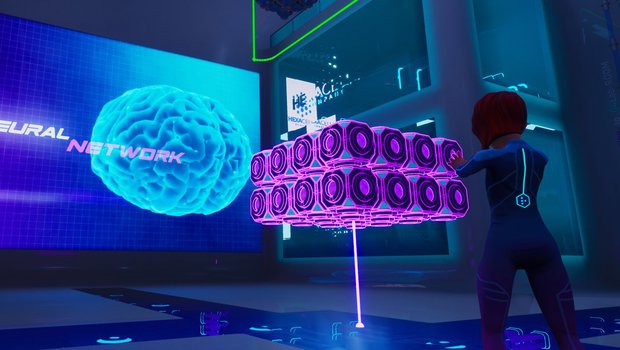Twogether: Project Indigos – Chapter 1 review

- 0 Comments
Still a few design traps to escape in otherwise promising single-player tandem escape puzzler
Rafi and Sam are two children gifted with supernatural powers. The Hexacells laboratory has kidnapped them and other kids to harvest their brain fluid in order to grant those powers to rich buyers. When one scientist frees Rafi and Sam in the Hexacells complex, it’s up to players to guide both to freedom, using their unique abilities in tandem. Developed by Flaming Llama Games and Gammera Nest, the first episodic installment of Twogether: Project Indigos pits the kids against a sequence of environmental puzzles in a third-person 3D world. Though the level design could use some work, combining the powers of Rafi and Sam is fun and their personalities are engaging enough to make for a promising start to the series.
Through a series of stylish subtitled paintings, the introduction establishes the plight of the children kidnapped by Hexacells. Then a mysterious, silhouetted woman is shown releasing Rafi and Sam – and only Rafi and Sam of all the inmates – into the complex. The two kids meet in short order and form an alliance to escape. Rafi is a pessimistic girl, pissed off at her captivity, who can move and manipulate objects with the power of her mind. Sam is a boy who sees the bright side of everything and has the power to teleport to any place he can throw his Rubik’s cube to. The differences in their personalities makes for some fun exchanges, especially with Sam being willing to trust Rafi right from the beginning but Rafi being much more guarded and withdrawn.

The complex the two are imprisoned in is like a cross between the testing chambers of Portal and the neon-glowing lights of the movie Tron. While it certainly gives the game a distinctive look, it’s a style that impinges on the playing experience. With so many bright lights set against relative darkness, it’s a little eye straining, such that I’d recommend rest breaks even though the game only has a two-hour runtime. The other downside to the starkly contrasting lighting is that many things in the environment seem important because they’re glowing, but few actually are, and they tend to get lost in the visual frenzy.
Twogether is played from an over-the-shoulder perspective, with a chase cam following whichever character is currently active. During the early tutorial section, the game offers only one protagonist at a time to control. After they meet up, you can freely switch between the two with the press of a button. It’s a shame, though, that the camera is not particularly well-implemented here. In some of the closer-confined levels, I repeatedly had difficulty getting the camera oriented so I could see what I was trying to look at, with things like walls, floors, and stacks of crates getting between me and whichever character I had selected.
While both the visual design and camera control could use some tweaking, fortunately the gameplay itself is quite engaging. Rafi can use her abilities to, most of the time, manipulate distant control panels as well as to levitate objects. A tap of a button puts her into telekinetic mode, in which a crosshair is displayed on-screen. Sweeping this over an item she can manipulate then causes that object to glow, and another button tap starts her power and then movement controls are used to guide around whatever she’s focused on. For Sam, tapping a button causes him to draw out his Rubik’s cube and a glowing arc appears showing the trajectory along which the cube can be thrown. The direction and distance can both be altered, and then it’s a simple button press to toss the cube. Individually, a lot can be done with the characters’ powers, but they can also work together. Sam can only toss the cube a short distance, but Rafi can then use her ability to move it beyond that, giving Sam the chance to teleport much farther than he could otherwise.
As the children progress through the game, they are placed in a series of chambers that act as puzzle boxes in need of solving. These typically require alternating between the kids’ powers to allow them to advance. For example, Rafi may need to use her ability to hold a distant control switch that disables a security field in an adjacent room, so Sam can throw his Rubik’s cube inside and teleport there in order to trigger another switch opening a door for Rafi. A surprising variety of challenges has been packed in based just on the characters’ abilities, and it’s a lot of fun sorting out how to use them together.

Progress is highly linear, with each puzzle room proceeding in order with seemingly only one correct solution per room. And yet despite this streamlining, I struggled on more than one occasion to determine exactly where I was trying to go. In fact, I had to consult a “Let’s Play” video several times. Never for any puzzle solutions but simply to figure out where in the cluttered environments I needed to get to.
For example, one sequence has the pair following a conveyor belt with green beams of light shining on it, which will knock them out if they touch it, resetting them to back before they started on the belt. Successfully navigating this obstacle places the two in a room with a series of large wall panels and one open passage at the far end that leads to … a dead end. I was certain that must be the way to go since it was clearly signposted as an open passage. After twenty minutes of fruitless searching and experimentation, I checked the Lets Play only to discover that the correct way to proceed was to manually position both characters in front of one of the panels in the previous room to cause that particular panel, which looked identical to all the other ones in the room, to open. (Sorry for the spoiler, but you’ll thank me later.)
Other inconsistencies in the gameplay made me feel more like I was debugging Twogether than playing it at times. For instance, Rafi’s telekinesis ability allows her to use computer panels and switches that she can see through glass, even if she can’t physically reach them. Usually, at least. Sometimes I encountered switches that I could use her power on but it would do nothing, leaving me wondering if I was pressing the wrong buttons on my controller or if her power just didn’t work there. In another place, Sam was trapped in a dead end with a force field in the floor that blocked him from going through. Given the back-and-forth nature of the game between the two characters, I expected I had to do something with Rafi to deactivate the force field. However, it turned out that Sam could simply drop his Rubik’s cube through the field and then teleport to the other side. In fairness, this does occur once during the game’s early tutorial, but a force field that stops some things and not others, is inconsistent enough that I’d forgotten it, even with the game’s short play time.
On the audio front, the game gets the job done but doesn’t particularly excel. Tense, moody escape music accompanies Sam and Rafi throughout, though neither of the characters have their own themes. The rest of the soundscape consists of ambient noises like the soft tread of the pair’s footsteps, the distant blaring of alarms, and the vaguely electronic synthesized noises of the kids’ powers when in use. Dialog between the characters is done entirely via subtitles with no voice-overs. Even so, the personalities of the kids nicely shine through in their well-written lines.
Final Verdict
With its distracting level design and idiosyncrasies in how the world works, Twogether: Project Indigos is certainly a little rough around the edges. So it says something about the core gameplay and the children’s story of escape that I still had a lot of fun playing it. Importantly, it bills itself as “Chapter 1” and the game indeed ends on an emotional cliffhanger that I would love to see resolved. Even better, being the first installment, hopefully this provides the developers the opportunity to learn from player experiences so that they can address the shortcomings in the future. It’s certainly a series with potential, so if you like tandem gameplay puzzling, you should mostly enjoy this brief first taste of hopefully more and bigger courses to come.
Hot take
Cluttered level design and a lack of polish somewhat mar this episodic series debut, but they don’t stop Twogether: Project Indigos from being a fun and clever prison escape with its endearing telekinetic and telepathic leads.
Pros
- Combining character powers makes for clever puzzle solutions
- Diverse variety of challenges
- Differing personalities play off one another well
Cons
- Level design makes it hard to tell where to go and what to do
- Camera control is poor
- Puzzle solving sometimes simpler than figuring out what the game wants
Richard played Twogether: Project Indigos – Chapter 1 on PC using a review code provided by the game's publisher.











0 Comments
Want to join the discussion? Leave a comment as guest, sign in or register in our forums.
Leave a comment